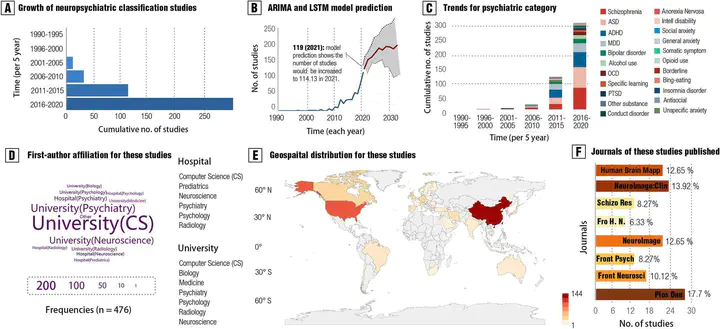Sampling inequalities affect generalization of neuroimaging-based diagnostic classifiers in psychiatry

摘要
Background The development of machine learning models for aiding in the diagnosis of mental disorder is recognized as a significant breakthrough in the field of psychiatry. However, clinical practice of such models remains a challenge, with poor generalizability being a major limitation. Methods Here, we conducted a pre-registered meta-research assessment on neuroimaging-based models in the psychiatric literature, quantitatively examining global and regional sampling issues over recent decades, from a view that has been relatively underexplored. A total of 476 studies (n = 118,137) were included in the current assessment. Based on these findings, we built a comprehensive 5-star rating system to quantitatively evaluate the quality of existing machine learning models for psychiatric diagnoses. Results A global sampling inequality in these models was revealed quantitatively (sampling Gini coefficient (G) = 0.81, p < .01), varying across different countries (regions) (e.g., China, G = 0.47; the USA, G = 0.58; Germany, G = 0.78; the UK, G = 0.87). Furthermore, the severity of this sampling inequality was significantly predicted by national economic levels (beta= -2.75, p < .001, R2adj = 0.40; r = -.84, 95% CI -.41 to -.97), and was plausibly predictable for model performance, with higher sampling inequality for reporting higher classification accuracy. Further analyses showed that lack of independent testing (84.24% of models, 95% CI 81.0-87.5%), improper cross-validation (51.68% of models, 95% CI 47.2-56.2%), and poor technical transparency (87.8% of models, 95% CI 84.9-90.8%)/availability (80.88% of models, 95% CI 77.3-84.4%) are prevailing in current diagnostic classifiers despite improvements over time. Relating to these observations, model performances were found decreased in studies with independent cross-country sampling validations (all p < .001, BF10 > 15). In light of this, we proposed a purpose-built quantitative assessment checklist, which demonstrated that the overall ratings of these models increased by publication year but were negatively associated with model performance. Conclusions Together, improving sampling economic equality and hence the quality of machine learning models may be a crucial facet to plausibly translating neuroimaging-based diagnostic classifiers into clinical practice.